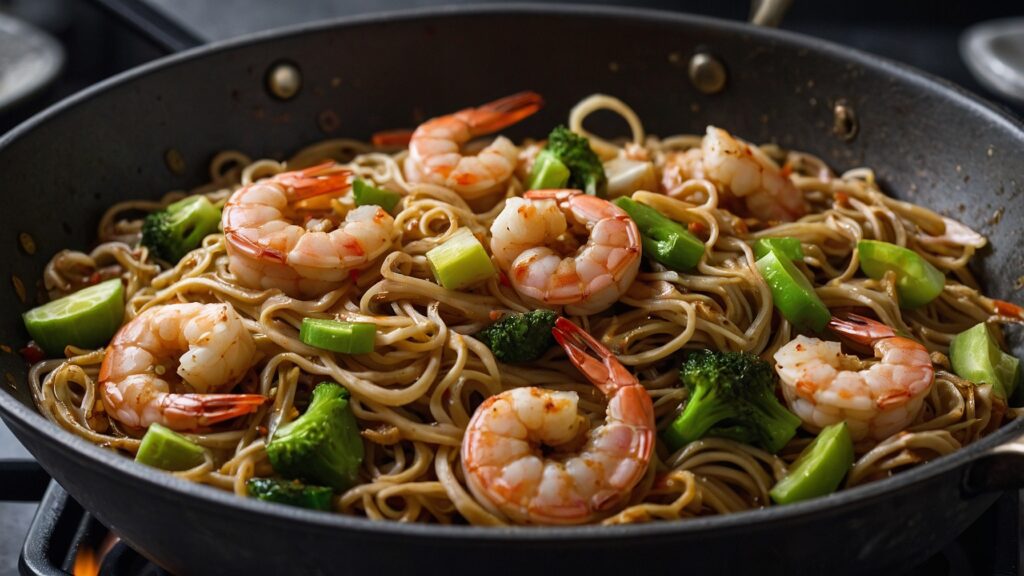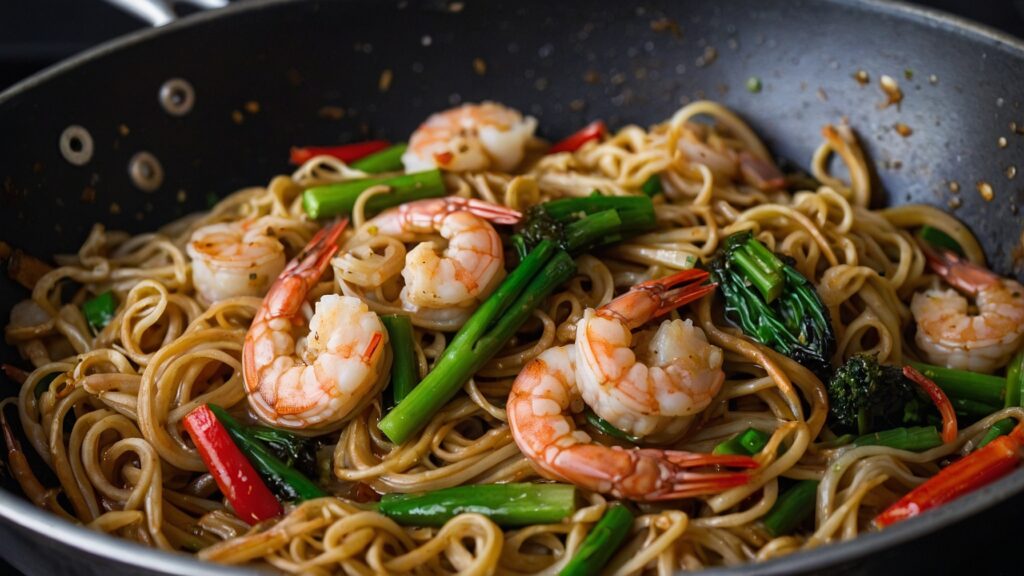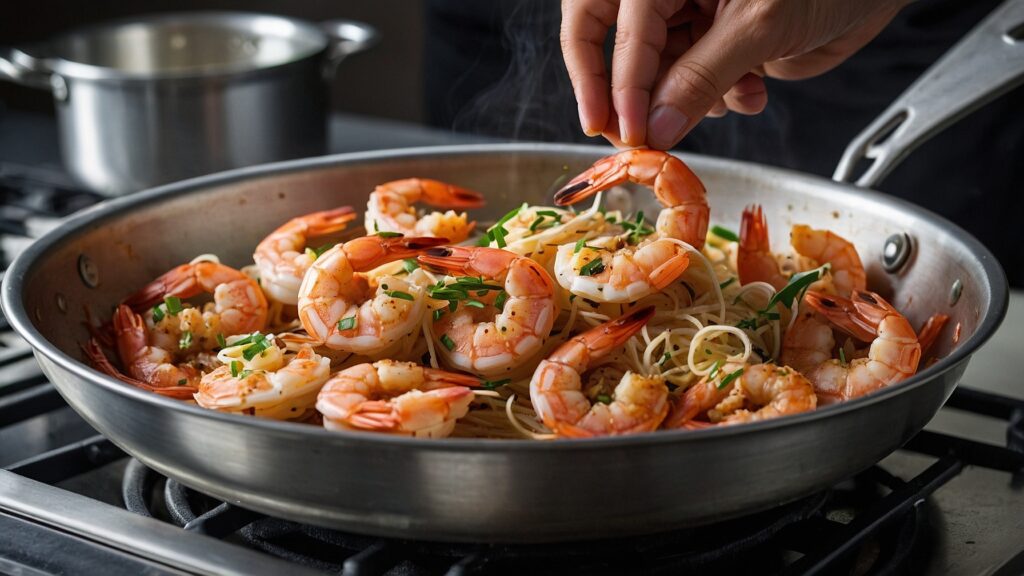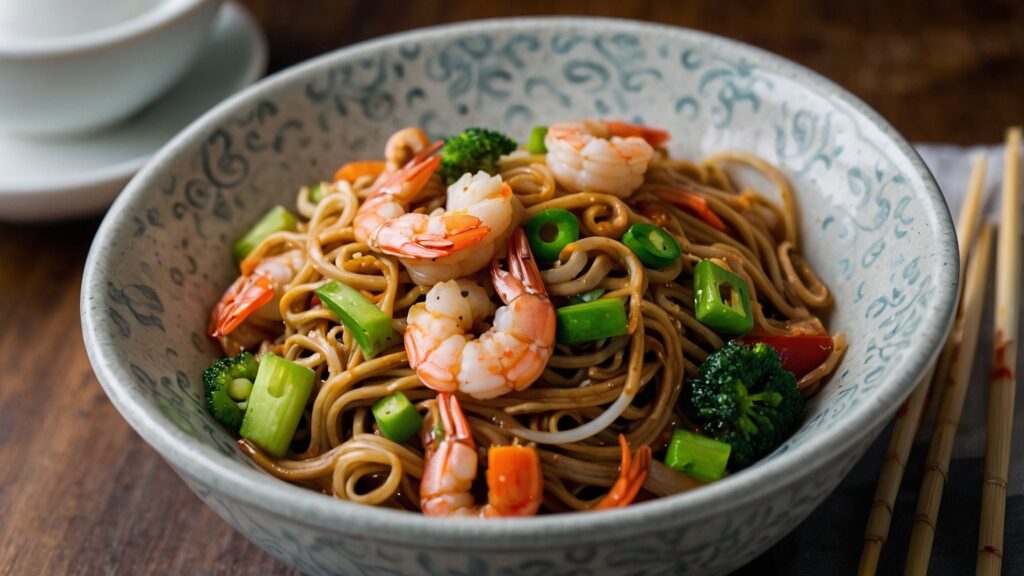Savory Shrimp Lo Mein Delight stands as a tribute to the seamless integration of American and Chinese culinary influences, offering a dish that is both satisfying and versatile.
The combination of tender shrimp, vibrant vegetables, and perfectly cooked lo mein noodles creates a meal that is not only flavorful but also visually appealing.
As we explore the intricacies of its flavor profile and the techniques that elevate this dish, one may begin to appreciate the potential for customization and the role each ingredient plays in achieving culinary harmony.

Recipe Overview
Savory Shrimp Lo Mein is a delightful main course that artfully blends American and Chinese culinary traditions, offering a symphony of flavors that include savory, heat, sweet, and umami notes.
This dish is not only quick to prepare, making it ideal for weeknight meal prep, but it also allows for creative ingredient substitutions.
For instance, if lo mein noodles are unavailable, spaghetti can serve as an excellent alternative without sacrificing texture.
Additionally, the versatility of vegetables—ranging from bell peppers to snow peas—enables you to tailor the dish based on seasonal produce or personal preferences.
Savory Shrimp Lo Mein Delight
Ingredients:
- 8 oz lo mein noodles (or spaghetti as a substitute)
- 1 lb large shrimp (26/30 per pound), peeled and deveined
- 2 tbsp peanut oil
- 1 bell pepper, sliced
- 1 cup snow peas
- 1 carrot, julienned
- 1 cup bean sprouts
- 2 green onions, chopped
For the sauce:
- 3 tbsp soy sauce
- 2 tbsp oyster sauce
- 1 tsp sesame oil
- 1 clove garlic, minced
- 1 tsp ginger, grated
- 1 tbsp white wine or chicken broth
Instructions:
- Cook noodles according to package instructions until al dente (about 4 minutes). Drain and set aside.
- In a small bowl, mix all sauce ingredients. Set aside.
- Heat peanut oil in a large skillet or wok over medium-high heat.
- Add shrimp and cook until they form a C shape, about 2-3 minutes. Remove and set aside.
- In the same skillet, add bell pepper, snow peas, and carrot. Sauté for 4-5 minutes until vegetables are crisp-tender.
- Deglaze the pan with white wine or chicken broth, allowing it to reduce by half.
- Add the sauce to the skillet and bring to a boil. Reduce heat and simmer until slightly thickened.
- Return shrimp to the skillet and add the cooked noodles. Toss everything together until well combined and heated through.
- Fold in bean sprouts and cook for an additional minute.
- Garnish with chopped green onions before serving.
Nutritional Information (per serving):
- Calories: 404 kcal
- Carbohydrates: 54g
- Protein: 31g
- Fat: 6g
- Fiber: 4g
Flavor Profile
While each ingredient contributes its own distinct character, the flavor profile of Shrimp Lo Mein is a harmonious blend of savory, sweet, and umami elements that tantalize the palate.
The dish achieves a perfect spice balance, allowing the natural sweetness of shrimp and vegetables to shine through, while a hint of heat adds an exciting dimension.
This interplay is further enhanced by the rich, aromatic sauce that coats the noodles, delivering a satisfying depth.
The textural contrast between the tender shrimp and crisp vegetables creates an engaging mouthfeel, making each bite a delightful experience.
This innovative combination not only pleases the taste buds but also invites culinary exploration, making Shrimp Lo Mein a standout choice for those seeking bold flavors.

Cooking Instructions
To kick off the cooking process for Shrimp Lo Mein, begin by heating peanut oil in a skillet over medium-high heat until it shimmers.
Sauté the shrimp briefly, ensuring they reach a perfect C shape, indicating doneness. For a nuanced flavor, deglaze the skillet with white wine or chicken broth, allowing it to reduce by half.
Next, incorporate your choice of vegetables—onions, peppers, and carrots—cooking for 4-5 minutes using effective sautéing techniques.
Add your sauce, bringing it to a boil before simmering for thickening.
Finally, fold in fresh bean sprouts and al dente lo mein noodles, garnishing with green onions.
Consider spaghetti as a clever substitute for noodles, enhancing versatility in this delightful dish.
Ingredient Selection
Selecting the right ingredients is essential for crafting a delicious Shrimp Lo Mein that captures the essence of its flavorful profile.
Emphasizing vegetable variety enhances both the visual appeal and nutritional value of the dish. Fresh, vibrant vegetables like bell peppers, snap peas, and carrots not only add crunch but also complement the savory shrimp.
The sauce balance is equally vital, as it binds the dish together, infusing each bite with umami richness. A harmonious blend of soy sauce, oyster sauce, and a hint of sesame oil will elevate your Lo Mein, ensuring that every ingredient shines.
Shrimp Preparation Tips
Achieving the perfect shrimp for your Lo Mein begins with careful selection and preparation. Opt for large shrimp, specifically those labeled 26/30 per pound, ensuring ideal texture and flavor.
For frozen shrimp, employ effective shrimp thawing methods by submerging them in cool water for rapid defrosting. Once thawed, pat them dry to enhance browning during cooking.
Elevate your dish with innovative shrimp seasoning techniques; consider marinating the shrimp in a blend of soy sauce, garlic, and ginger for at least 15 minutes before sautéing. This not only infuses flavor but also tenderizes the shrimp.
Noodle Cooking Methods
Once the shrimp are perfectly prepared, attention turns to the noodles, which play an essential role in the overall texture and enjoyment of the dish.
Selecting the right noodle type is vital; lo mein noodles are traditionally used for their chewy yet tender texture, lending a delightful mouthfeel. Cooking these noodles al dente—usually in just 4 minutes—preserves their integrity, preventing a mushy outcome that can detract from the dish.
Alternatively, spaghetti can serve as a quick substitute, offering versatility without compromising the dish’s essence.
Experimenting with various noodle textures can elevate your lo mein experience, allowing for innovative interpretations while maintaining the savory harmony that defines this delightful dish.

Broth and Sauce Options
A variety of broth and sauce options can greatly enhance the flavor profile of your savory shrimp lo mein.
Consider broth variations such as Shaoxing wine, chicken broth, or a rich seafood broth to infuse your dish with depth and character. Each option offers a unique base, allowing the umami notes to shine through while complementing the succulent shrimp.
For sauce alternatives, explore combinations like a spicy sesame-soy blend, a tangy ginger-garlic sauce, or a zesty citrus-infused glaze.
These innovative sauces can elevate the dish, bringing a delightful fusion of flavors. Experimenting with these broth and sauce choices not only personalizes your lo mein but also creates an unforgettable dining experience that excites the palate.
Storage Guidelines
Proper storage of savory shrimp lo mein is key to maintaining its delightful flavors and textures, ensuring that leftovers can be enjoyed to their fullest potential.
To maximize freshness, promptly transfer any uneaten portions into an airtight container. Refrigerate for up to three days, or freeze for up to three months, providing an excellent opportunity for meal prep.
When considering leftover ideas, think creatively: repurpose lo mein into stir-fried rice or a hearty soup. This not only reduces waste but also transforms your dining experience.
Keep in mind that proper storage not only preserves taste but also enhances the versatility of this dish, making it an innovative option for any busy weeknight or spontaneous gathering.
Reheating Techniques
How can you guarantee that your reheated savory shrimp lo mein retains its delightful textures and vibrant flavors? Employing effective reheating methods is essential.
For best results, consider using a skillet on medium heat, allowing the dish to warm evenly while preserving the shrimp’s tender texture. Stir frequently to prevent sticking and guarantee uniform heating.
Alternatively, a makeshift double boiler offers gentle heat, minimizing the risk of overcooking. For noodles, avoid the common pitfall of mushiness by utilizing a timer, reheating just until warmed through.
Adding a splash of broth or water can rejuvenate the dish, enhancing moisture while maintaining texture. With these techniques, your savory shrimp lo mein will taste as fresh and flavorful as the day it was made.

Nutritional Information
Reheating savory shrimp lo mein not only preserves its delightful textures but also maintains its nutritional integrity.
This dish offers a commendable caloric breakdown, with approximately 404 kcal per serving, providing a balanced mix of carbohydrates (54g), protein (31g), and healthy fats (6g).
The shrimp contributes essential protein and omega-3 fatty acids, while the vibrant vegetables enhance the meal with vitamins A and C, promoting immune health.
Additionally, the inclusion of fiber (4g) aids digestion, making this dish both satisfying and nourishing.
The use of low-sodium broth options can further reduce sodium content, allowing health-conscious individuals to enjoy the ingredient benefits without compromising flavor.
Serving Suggestions
Serving Savory Shrimp Lo Mein presents an opportunity to elevate your dining experience with thoughtful pairings and presentation.
For an innovative culinary journey, consider the following suggestions:
- Pairing Wines: A crisp Chardonnay or a light Pinot Grigio beautifully complements the umami flavors, enhancing the dish’s savory notes.
- Side Dishes: Serve with steamed bok choy or a tangy cucumber salad for a revitalizing contrast.
- Garnishes: Top with crushed peanuts or sesame seeds to add texture and crunch, enhancing visual appeal.
- Presentation: Use vibrant plates that showcase the colorful ingredients, creating an enticing visual experience that entices the palate before the first bite.

